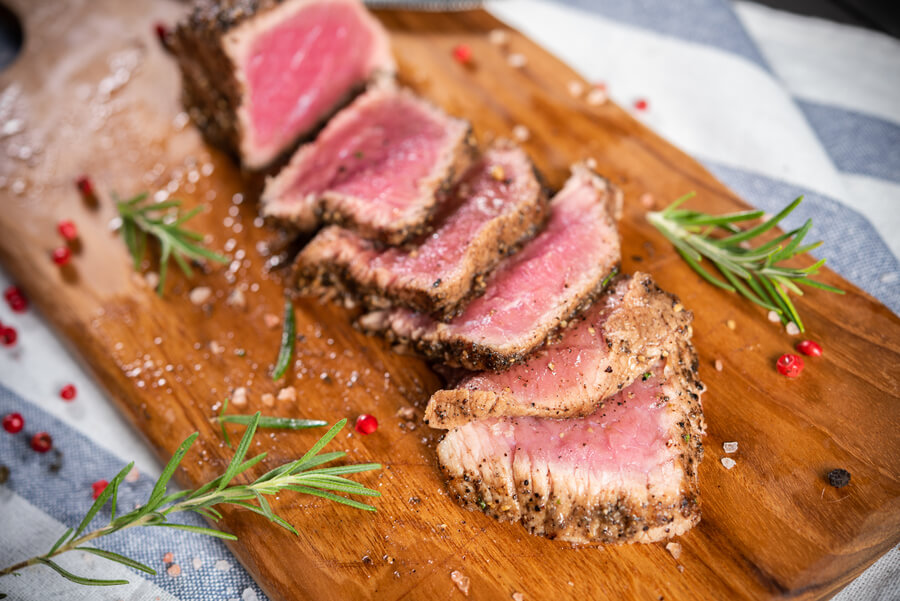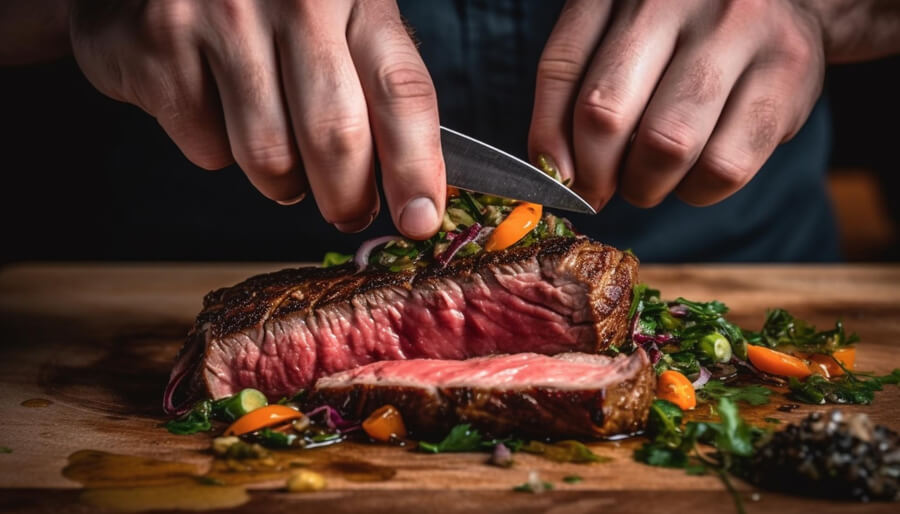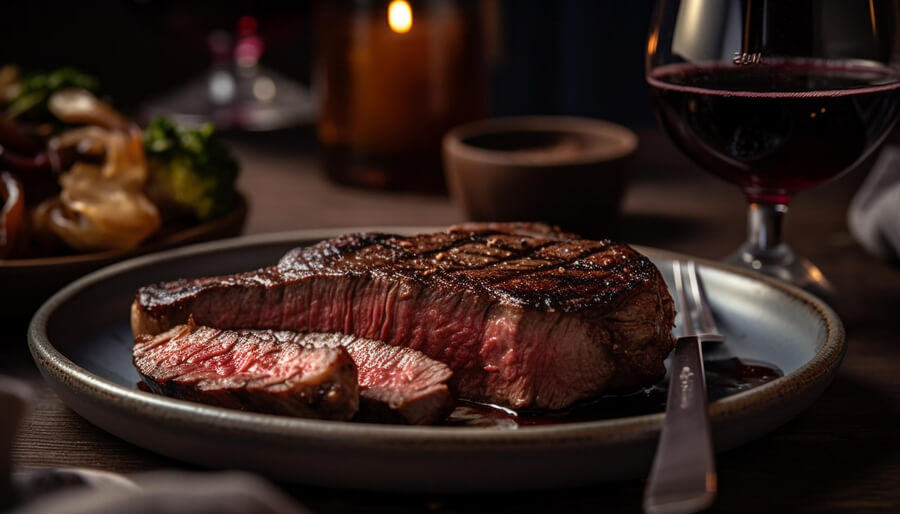Consuming undercooked or uncooked steak can be detrimental to your health. It can cause temporary concerns and even long-term health complications. Avoiding food poisoning when it comes to steak is quite simple.

All you need to do to prevent the risks of eating an undercooked steak is to prepare your meat correctly.
How to Prevent Food Poisoning from Undercooked Steak
To prevent food poisoning from undercooked steak, you must practice safe cooking practices. Here’s a guide on how to do that.
Choose Quality Meat
Always use a good quality cut of beef. This would reduce the risk of contamination even before cooking. Choosing quality meat is the first step to prevent food poisoning. High-quality meats are often produced and handled with better hygiene and safety standards.
These meats are less likely to contain harmful bacteria, parasites, or viruses. By selecting quality meat, you reduce the risk of introducing pathogens into your cooking. This also dramatically lowers the likelihood of foodborne illnesses.
Store your Meats Properly
Keep raw steak separate from other foods. Also, store it in the refrigerator at or below 40°F (4°C). Bacteria that can cause food poisoning multiply rapidly when raw meat is unrefrigerated.
Therefore, it is vital to keep your raw meat cold until you’re ready to cook it. To keep your raw meat safe, after purchasing your steaks, put them in the refrigerator right away. Raw steaks shouldn’t be left in a hot car.
You could keep raw meat in an insulated cooler if you weren’t heading home immediately from the store. It helps in keeping the meat cold. Directly you arrive home, place the raw meat in the refrigerator or freezer. Also, steak should not be left out at room temperature.
Thaw the Steak in the Refrigerator
If your steak is frozen, thaw it in the refrigerator. This is better and safer than on the countertop to avoid bacteria growth. Refrigerators have a consistent, cool temperature, typically around 40°F (4°C).
This environment slows down bacterial growth and reduces the risk of pathogens on the surface of the steak. However, thawing in the refrigerator may take longer than other methods, like thawing on the countertop.
However, it’s a safer and more controlled process. Slower thawing allows for more even and controlled temperature changes. It also minimizes the risk of bacterial accumulation. Besides, by thawing in the refrigerator, you can maintain the quality of the meat. You prevent the outer layers from partially cooking due to room temperature.
Cook with Clean Hands and Surfaces
Cooking with clean hands and clean surfaces is a fundamental kitchen hygiene tip. Wash your hands, utensils, or any surfaces you use for the steak with hot, soapy water. Do this before and after handling raw steak.
From meal preparation to plating, sanitation reduces the risk of contamination throughout the cooking process. Also, sanitation is essential to prevent cross-contamination. Reduce the risk of transferring harmful bacteria from raw steak to other foods or kitchen equipment.
Touching raw meat can transfer bacteria like Salmonella or E. coli to your hands. When these bacteria come into contact with other foods, they can multiply. They can also cause illness if not thoroughly cooked.

Use a Meat Thermometer
Invest in a meat thermometer to ensure an accurate temperature when you’re cooking. The United States Department of Agriculture recommends an internal temperature of 145°F (63°C) for medium-rare steak.
The meat thermometer is considered an essential tool for chefs in the kitchen. First, it helps determine the ideal cooking temperature for a perfectly cooked steak. It also ensures that your steak is safely prepared.
Use Safe Cooking Methods
You could cook steak thoroughly using methods like grilling, broiling, or pan-searing. Make sure the heat reaches the center of the meat. These methods ensure that the steak reaches a high enough internal temperature.
This would kill harmful bacteria, parasites, or viruses that may be present in the meat. This lets you achieve the desired taste and texture and won’t compromise food safety. A reliable cooking method ensures that the entire steak is evenly cooked. Leave no undercooked areas that may harbor pathogens.
Resting Time
Allow steak to rest after a few minutes to redistribute juices and finish cooking. It is advisable to let your steak rest for a minimum of 3 minutes before eating or indulging in it. Some professional chefs even suggest a full 10 minutes of resting after cooking.
Avoid Cross-Contamination
Do not use the same platter or utensils for cooked steak that were used for raw meat. Cross-contamination is the transfer of harmful microorganisms from one food or surface to another.
This can happen when you use the same platter or utensils you used for raw meat for already-cooked steak. You risk transferring any bacteria in the raw meat to the cooked steak. This can make the steak unsafe to eat and lead to food poisoning.
To prevent this, it’s essential to use separate platters, cutting boards, and utensils for raw meat and cooked food. This practice helps maintain food safety and reduces the chances of contamination. It ensures that your cooked steak remains safe to eat and enjoyable.
Refrigerate Leftovers Quickly
Leftover cooked steak should be refrigerated within two hours. Proper storage also comes into play after cooking. You should ensure leftovers are promptly refrigerated to prevent bacterial growth. Also, before consumption, It should be reheated to an appropriate temperature.
Be Cautious with Ground Beef
Ground beef has a higher risk of contamination. Unlike whole cuts of steak, ground beef should not be served rare or medium-rare, as it’s more susceptible to bacterial contamination.
Cook it until there is no pink in the center. Always get your ground beef from reputable sources, and check the expiration date. Ground beef, especially those with higher fat content, can be more susceptible to bacterial growth.
Therefore, it is essential to be extra cautious with such varieties. Ensure it reaches an internal temperature of 160°F (71°C) and use it within 1-2 days.
Sear the Steak
Sear the steak at a high temperature on both sides before finishing in the oven or grill. This not only enhances flavor but also helps eliminate surface bacteria. This reduces the incidence of food poisoning.
Avoid Rare Steak

If you’re concerned about food safety, you could avoid rare or undercooked steak altogether. An irregular or medium-rare means the internal temperature while cooking remains relatively low.
In this case, the bacteria present on the surface of the meat can survive. This could lead to food poisoning when consumed. Understandably, some people enjoy the taste and texture of rare or medium-rare steak.
However, it would help if you balanced your preference with food safety. You can still enjoy a tender and flavorful steak if you cook it to the recommended safe temperatures.
Final Thoughts on Avoiding Undercooked Steaks?
Consuming undercooked steak can lead to foodborne illnesses. It causes symptoms like nausea, vomiting, diarrhea, or even more severe health complications.
Cooking steak to the recommended temperature ensures it’s safe to eat and minimizes the risk of food poisoning. When you follow these steps, you can reduce the risk of food poisoning from undercooked steak.
